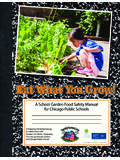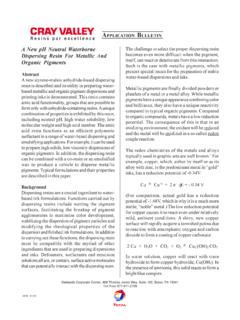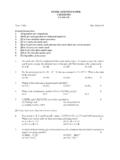Transcription of Soil Stories - lifelab.org
1 Soil Stories Second Grade Science Exploration Students dig into dirt and discover the secrets of the intricate ecosystem living beneath their feet. After discovering soil's components, students take the next steps to become stewards of the soil. Soil Stories Second Grade Science Exploration Life Lab Science Program Contents Teacher Science Recommended Master Materials Sinking Into Soils (pre-assessment activity)..6. Space Travelers ..8. Sensual Soil ..10. Does it Hold Water? ..12. Which Soil do Plants Prefer? ..14. The Great Book of Soil (post-assessment activity)..19. Life Lab Science Program 2007. Teacher Introduction These exploration lessons are a product of the field trip proram at Life Lab's Garden Classroom in Santa Cruz, CA and can be used in your own school garden or classroom. Scoop up a handful of soil and you may see pebbles, grains of sand, bits of leaves and twigs, a piece of bone, or perhaps even an ant or earthworm.
2 If you were to look at the soil through a microscope, you would find a busy world of tiny animals moving around and through the soil particles. Soil is crowded with living crea- tures, ranging from microscopic bacteria and fungi, to earthworms and millipedes, to gophers and moles. Soil provides the foundation for life on Earth. From the soil grow plants that provide food for people and other animals. Without soil, none of us could survive. During their Soil Stories Investigation students dig and discover. They dig up a spadeful of soil and discover a dynamic mixture of living, once-living, and nonliving things. They practice sorting and classifying the tiny particles they find in soil. As they explore that spadeful of soil and compare it to soil from other places, they deepen their understanding of how soil is made. They also set up an experiment to test the water holding capacity of soil, and predict how soil structure will affect drainage.
3 Students learn that the structure of the soil functions as a key factor in the lives of plants and animals living in it. They are all parts of a tightly linked system. Students experience a different side of soil when they use multiple senses to learn about how soils differ. They complete a fun language arts activity to link their soil studies to oral and written language. Then students perform stewardship tasks in the garden to give back to the soil for the health of the garden. Science Standards The California Science Standards listed below will be addressed during the Soil Stories Investigations. Earth Sciences: 3. Earth is made of materials that have distinct properties and provide resources for human activities. As a basis for understanding this concept: a. Students know how to compare the physical properties of different kinds of rocks and know that rock is composed of different combinations of minerals.
4 B. Students know smaller rocks come from the breakage and weathering of larger rocks. c. Students know that soil is made partly from weathered rock and partly from organic materials and that soils differ in their color, texture, capacity to retain water, and ability to support the growth of many kinds of plants. e. Students know rock, water, plants, and soil provide many resources, including food, fuel, and building materials that humans use. Investigation and Experimentation: 4. Scientific progress is made by asking meaningful questions and conducting careful investigations. As a ba- sis for understanding this concept and addressing the content in the other three strands, students should develop their own questions and perform investigations. Students will: a. Make predictions based on observed patterns and not random guessing. b. Measure length, weight, temperature, and liquid volume with appropriate tools and express those measurements in standard metric system units.
5 C. Compare and sort common objects according to two or more physical attributes ( , color, shape, texture, size, weight). d. Write or draw descriptions of a sequence of steps, events, and observations. e. Construct bar graphs to record data, using appropriately labeled axes. f. Use magnifiers or microscopes to observe and draw descriptions of small objects or small features of objects. Life Lab Science Program 2007 1. Resources Story Books The Earth Is Sore: Native Americans on Nature. By Amon, Aline, adap. New York: Atheneum, 1981. This is a collection of poems and poetic statements about earth and sky by Native Americans. Everybody Needs a Rock. By Byrd Baylor. New York: Scribners, 1974. Find out how to hunt for a rock no, the right rock. Mole Moves House. By Elizabeth Buchanan. New York: Doubleday, 1989. An exuberant mole refuses to believe that his human neighbors think he is a pest.
6 The Magic School Bus inside the Earth. By Joanna Cole. New York: Scholastic, 1987. A special field trip on the magic school bus allows Ms. Frizzle's class to get a first-hand look inside the Earth. The Quicksand Book. By Tomie dePaola. New York: Holiday, 1977. An adventure in the jungle leads to a discussion of the composition of quicksand .. and rescue procedures. This book also tells how to make your own quicksand. Deep Down Underground. By Olivier Dunrea. New York: Macmillan, 1989. In this counting picture book, garden animals present the numbers from one to ten, as earthworms, toads, ants and others march, burrow, scurry and scooch deep down underground. Small Pig. By Arnold Lobel. New York: Harper, 1969. A pig who has had his pen cleaned up by the farmer's wife, goes off in search of mud and discovers that good mud is hard to find. The Sun, the Wind and the Rain. By Lisa Peters. New York: H.
7 Holt, 1988. The earth forms a mountain, shaping it with the sun, wind, and rain, while a child, in a parallel effort at the beach, makes a tall sand mountain also affected by the elements. Once There Was a Tree. By Natalia Romanova. New York: Dial, 1985. This is a Russian tale about a de- composing tree. Even more story books are found here: The Good Kids' Book List, compiled by the The Junior Master Gardener Program and the American Horticultural Society, includes the top children's garden books of the last 100 years. California Foundation for Ag in the Classroom offers an extensive list of gar- den and nature based books for all grade levels. Life Lab Science Program 2007 2. Garden Songs The Banana Slug String Band has an extensive collection of environmental ed and garden-themed songs, including one of our favorites, Roots, Stems, Leaves. Find more at singing-in-our-garden. Or try out the following: This song was provided courtesy of The Banana Slug String Band, Hear Life Lab Staff singing garden related songs at our YouTube channel: Life Lab Science Program 2007 3.
8 Master Materials List: Soil Stories Sinking Into Soil 1 jar filled with soil from schoolyard or garden 2 large pieces chart paper Markers Drawing paper Colored pencils or crayons Space Travelers Per team of 3-4 students: 1 large sheet newspaper 2 trowels 1 egg carton 2 sets tweezers 1 hand lens Life Lab Field log and pencils Dissecting scope (optional). Sensual Soils 4 containers with different types of soil: Clay, compost, garden soil, sand Scrap paper or sticky notes 4 lunch-sized brown paper bags 4 large pieces construction paper Colored markers Does It Hold Water? Four lamp chimneys or plastic soda bottles with the bottoms cut off 4 moistened samples of very different soils: sand, clay, garden soil, compost Screen or cheesecloth Strong tape 4 quart jars 4 measuring cups Water Life Lab Field Log and pencils Life Lab Science Program 2007 4. Which Soil Do Plants Prefer? For the class: 4 different types of soil in plastic bags: compost, clay, sand, garden soil Our Ideas about Soil and Questions we have about Soil lists For Each Group of 5: 4 pot filled with one of the soil types 1 large spoon 1 ruler Label for pot Marking pen Bean seeds (Blue Lake or Bush Beans).
9 Measuring cups for water Which Soil do Plants Prefer? Log Sheet Great Book of Soil For the class: 1 seedling or seed Poster board for making the book cover Cardstock or other material for book binding Our Ideas about Soil list and Questions we Have about Soil list For Each Student: 1 sheet of drawing paper with lines Crayons or colored pencils Life Lab Science Program 2007 5. Sinking Into Soils (Pre-Activity Assessment). Description Students draw their ideas of what is in soil is in this pre-assessment activity. Objective To introduce the topic of soil and its importance, and to learn what students already know about soil. Teacher Background Many children have experiences with different soils, from making mudpies to sliding on the baseball diamond. What do your students really know about soil? What are their ideas about where it comes from and what it is made of? Their drawings and comments will provide you with information about what they are thinking about the nature of soil.
10 Materials 1 jar filled with soil from the schoolyard or garden 2 large pieces of chart paper Markers Drawing paper Colored pencils or crayons Life Lab Science Program 2007 6. Preparation Make two lists with the pieces of chart paper: Our Ideas about Soil and Questions we have about Soil. Post the lists where students can see them. Class Discussion Elicit students' ideas about soil by holding up the jar full of soil. What is the stuff in this jar? What is soil? How important is soil? Do you think all soils are alike? Why or why not? Record all their ideas about soil on the first list. Action Ask the children to think quietly about a favorite outdoor spot. It could be any place they have been where they come in contact with the earth, such as on the soccer field or in the school garden. Ask them to imagine that they are very tiny, and they sink down into the soil. Distribute colored pencils and paper.







